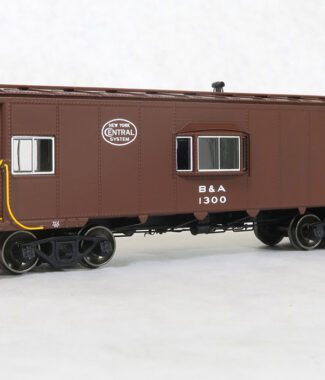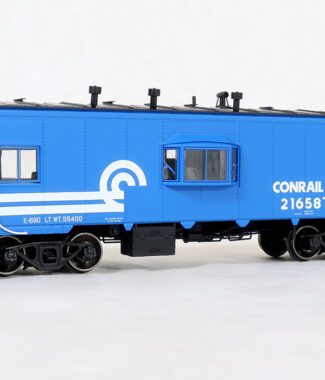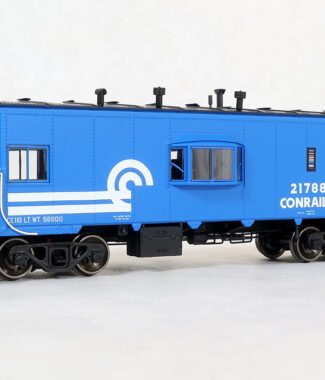Please click on the images at right for pricing, SKUs, high resolution photos, prototype photos, car number options, and/or to order!
In 2007, Tangent Scale Models started the trend of offering unparalleled railroad freight car replicas in HO scale, the likes of which had never been seen in the market. These highly-detailed replicas have consistently raised the bar for HO scale models with several hallmarks, including precision tooling, hyper-accurate stenciling, true to life colors, and era-specific details. Additionally, our models are designed to operate perfectly by including CNC-machined wheels, correct weights, and correct coupler heights. Simply put: We offer detailed freight cars on a higher level.
Fast forward to today’s release: our next release of “Tangent quality” HO scale cabooses. The era of “one size fits all” cabooses in HO scale plastic is over. We bring our passion and knowledge for translating real 1:1 railroad equipment from freight cars to cabooses. And we are taking things a step further, where our penchant for operations is accelerated with accurate marker lighting in era-specific versions!
Here is one of the Barnum and Bailey circus trains in 1967 with a trusty New York Central painted “Lot 827” caboose bringing up the markers.

Our NYC DSI caboose model is actually a system of cabooses from two builders: the HO scale Despatch Shops Incorporated (DSI) and St. Louis Car Company (SLCC) Bay Window Caboose System, which began as New York Central’s first foray into post-war steel cabooses. You know the cabooses – these are the super common cabooses that had riveted sides and offset bay windows – they were everywhere! They are most commonly referred to as Class N7 and N7As (in PC and Conrail terms) and were the largest bay window fleet in the PC and Conrail family! Yup, we have done a NYC caboose (also Illinois Terminal – keep reading)!
The DSI/SLCC Steel Bay Window cabooses were witnesses to incredible changes to railroading during their use. Perhaps your train features NYC FA-2 locomotives racing along the Water Level Route, an ITC Class C electric rocking-and-rolling through central Illinois, CR SD45s on Horseshoe Curve helper duty, or NW Geeps handing local duties in St. Louis? Well, we have a caboose for your train! Our 2023 run of cabooses:
Our DSI/SLCC Steel Bay Window “system” of cabooses includes these three build specifications:
Build #1: Despatch Shops Inc. NYC Lot 782 – N7 Class Steel Bay Window Caboose In 1949, the New York Central solved the problem of an aging wooden caboose fleet. NYC turned to its subsidiary, Despatch Shops Inc. in East Rochester, New York, who had built a small number of NYC steel cabooses in 1948. In 1949, DSI fabricated 95 cabooses for the NYC and 5 for the Boston & Albany under lot 782. These 100 cabooses featured a riveted steel construction with offset bay windows. The interiors included bay window seats, bunks, crew lockers, a coal stove and oil lamps for lighting. Between 1962 and 1967, these Lot 782 cabooses would be among the groups of cabooses refurbished at the NYC Beech Grove Shops in Indiana. The rebuilt Lot 782 caboose changes included electrical lighting, a battery charging system, and new oil stoves, along with new Century Green paint and a new number series. The Lot 782 fleet continued through the Penn Central merger – now identified as the N7 Class. Further changes would come during the 1970s, as modernization programs would remove running boards and add additional lighting. Conrail added a coat of blue paint, and the remaining fleet of N7 cabooses saw service into the mid 1980s, until they were purged from the Conrail caboose ranks.
Build #2: St. Louis Car Co. NYC Lot 827 – N7A Class Steel Bay Window Caboose In 1952, the New York Central continued to modernize its caboose fleet. While NYC subsidiary Despatch Shops Inc. in East Rochester, New York, had built 100 steel cabooses in 1949, the NYC asked St. Louis Car Company to build 200 additional cabooses in 1952 under lot 827. These cabooses followed the previous 1949 DSI design closely, with riveted steel construction and offset bay windows. The interiors included bay window seats, bunks, crew lockers, a coal stove and oil lamps for lighting. Between 1962 and 1967, these Lot 827 cabooses would be among the groups of cabooses refurbished at the NYC Beech Grove Shops in Indiana. The rebuilt Lot 827 caboose changes included electrical lighting, a battery charging system, and new oil stoves, along with new Century Green paint and a new number series. The Lot 827 fleet continued through the Penn Central merger — identified as the N7A Class. Further changes would come during the 1970s, as modernization programs would remove running boards and add additional lighting. Conrail added a coat of blue paint, and the remaining fleet of N7A cabooses saw service into the mid 1980s, until they were purged from the Conrail caboose ranks.
Build #3: St. Louis Car Co. Illinois Terminal Steel Bay Window Caboose In the 1950s, the Illinois Terminal Railroad was undergoing major changes in both operations and equipment. New GP7 locomotives delivered in 1953 started to replace electric freight motors on through freights, and the aging wood caboose fleet struggled to serve crew needs. As a result, the Illinois Terminal ordered 10 steel bay window cabooses from St. Louis Car Company in 1953. While these cabooses were close in appearance to a NYC order built by St. Louis Car Co. in 1952, the features and interiors were distinctly Illinois Terminal. These cabooses were a riveted steel construction with offset bay windows. Wood running boards and closed ends without windows gave the cabooses a unique look. The interiors included bay window seats, double bunks, crew lockers, a coal stove, 110V AC Service for lighting at the terminals and oil lamps for lighting on the road. Over the years, Illinois Terminal would paint these ten cabooses in a dizzying assortment of schemes, some lasting longer than others. Further changes would come during the 1970s, as the cabooses were modernized with the removal of the roof running boards, cut-down ladders, and additional lighting. The Norfolk & Western assumed operations of the Illinois Terminal in 1981, and several of these cabooses survived into the 1980s, refurbished in N&W Red Paint.
The Boston & Albany requested that DSI build 5 cabooses as well alongside the 95 going to NYC. These cars feature the classic 1949 white NYC graphics, with the distinctive “B&A” instead of “NYC” under the bay window. Here is a shot of 3 of the cabooses in Boston MA.
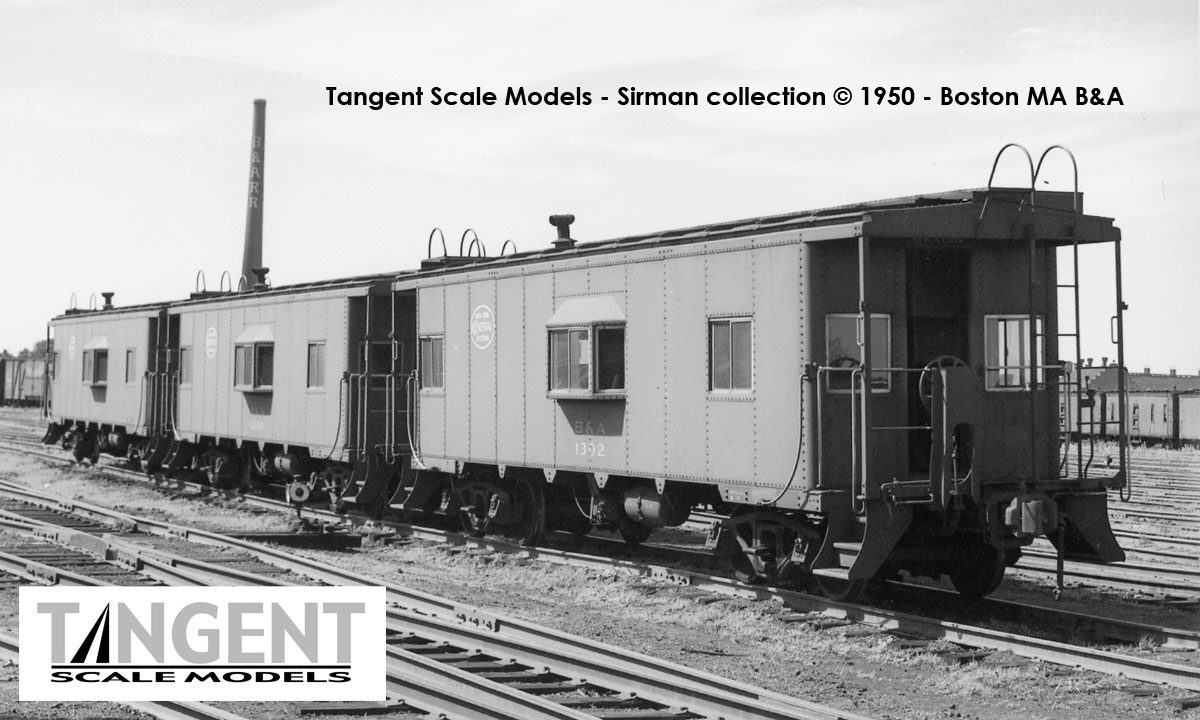
In 1955, New York Central (NYC) repainted some of the the 1949 DSI cabooses with the black-background NYC oval logo. NYC experts will spy that small, era-accurate triangle of paint code information on the left side along with repack stencil data and correct serial number on the right. Speaking of little details, the caboose includes an original DSI-applied smokejack, roof walkway, and end railings. The corner railings are painted yellow, along with the bottom “Kass” step tread on each corner. The caboose includes scale-size (unlit) oil lanterns mounted on one end on the corner railing posts.

New York Central repainted the brown cabooses into various different versions of century green. The earliest version of the century green repaint was applied by New York Central to the Lot 827 class. These St. Louis Car Company-built cabooses were shopped at NYC’s Beech Grove Shops in Indiana. The rebuilt Lot 827 caboose changes included electrical lighting, a battery charging system, and new oil stoves, along with new Century (“Jade”) Green paint and a new number series. Check out those distinctive roof vents added during rebuilding but the original SLCC “taller” style smokejack. These cabooses feature the NYC “cigar band” logo on the right side of the car and the NYC font stencils in the center under the bay window.
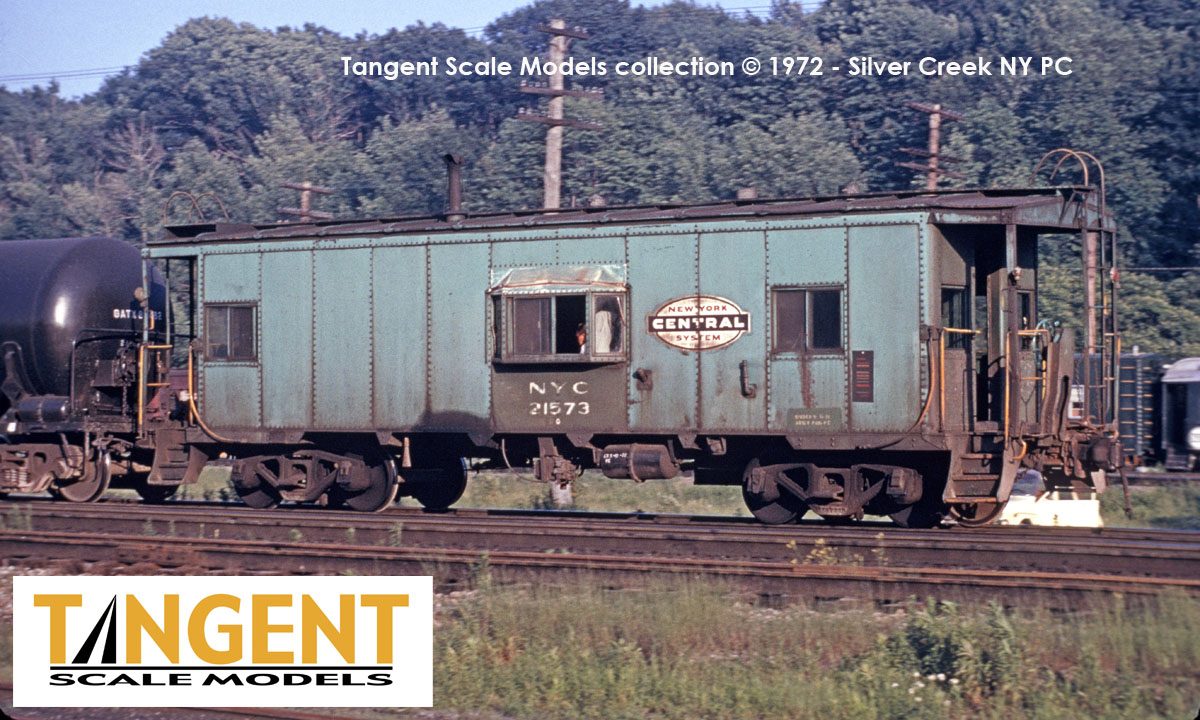
Following the Penn Central merger in 1967, the first of the century green cabooses were repainted into Penn Central. One of the first schemes featured the large white PC logo and italicized PENN CENTRAL on the carbody. This scheme featured a black roof, standard for PC, and maintained its running board and end ladders. PC carefully applied yellow paint to the corner grabs, bottom steps and rounded top ladder grabs. The caboose featured its original St. Louis Car Co. tall smokejack along with the NYC Beech Grove upgrades like rooftop vents. The cabooses included pyle markers mounted on both ends on the corner railing posts.

Following the creation of Conrail in 1976, and before Conrail created blue as the official caboose color, the earliest repaints of cabooses and other freight equipment were PC green. This was not a patch out of a former PC paint job, but instead was a full green repaint by Altoona’s paint crew in early May of 1976. This N7A had a modernized appearance per PC practice, where the running board and end ladders were removed along with adding end railings and the signature PC-style replacement smokejack. Notice the “POOL” denotation on the end doors of this caboose was used to denote its pool service status (i.e. it could run everywhere). ACI and those distinctive PC/CR COTS panels have been applied, which was standard for this era.

Some Conrail blue N7/N7A repaints did not lose their roof walkway and end ladders until receiving CR blue paint. The end railings are specific to this type of setup. Notice the vertical ladder stiles were maintained, even after the running board was removed by CR personnel. (The predecessor PC’s practice was to torch off these ladder stiles during modifications.) These N7 cabooses had the classic Conrail blue paint, with red ‘Scotchlight’ rectangles on the ends. Note the red marker light pairs on the ends. The Conrail cabooses continue the black-painted roofs found on the Penn Central cars, as well as 2-panel consolidated stencils.
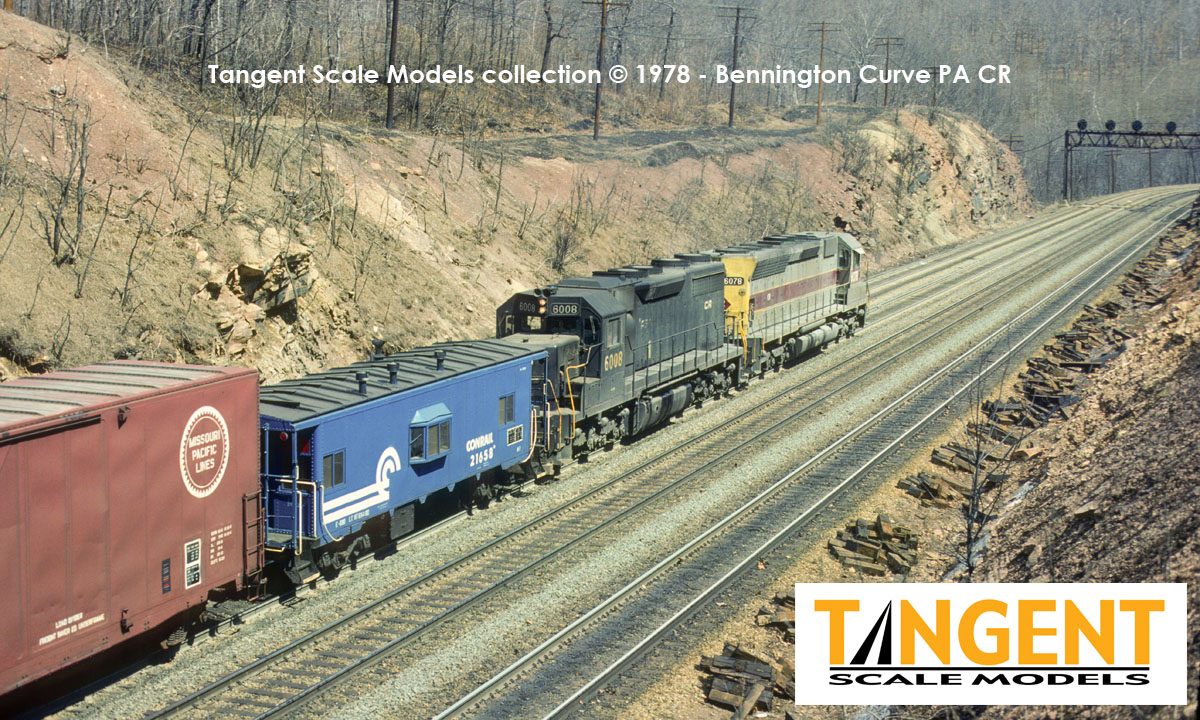
Conrail’s 1979 painted cabooses included accurate red and white red ‘Scotchlight’ stripe rectangles on the ends for visibility. Conrail removed the PC-era end marker lights when these cabooses were rehabbed, and instead substituted a single orange FRA-flasher light, mounted on end of the car. Yes, the 1977+ and 1979+ Conrail cabooses operated concurrently (and with PC cabooses, we might add). Finally, Conrail replaced the plain bearing trucks with 70-ton roller bearing trucks.

As referenced above in “Build #3,” St. Louis Car Company built these cabooses not only for NYC but for Illinois Terminal, delivered in 1953. The first Illinois Terminal scheme was delivered in a safety-inspired bright “target” red paint. The caboose also has other colors present on the exterior, including “canary yellow” handrails and steps. Additionally, the Standard Railway Equipment roof received a coat of light gray paint. The prototype Illinois Terminal lettering above the cupola and the ITC with road number was applied onto thin metal placards which were bolted onto the car side and had an off-white appearance. These cabooses also had large oil lanterns on one end of the caboose.
Illinois Terminal (ITC) “Delivery Target Red w/Stripes 1953+” demonstrates an example of the final two cabooses delivered to the ITC by St. Louis Car Company. These cars feature the same safety-inspired bright “target” red paint, but SLCC also applied white reflective delineators across the bottom of the body and ends. This is a very distinctive look. The caboose also has other colors present on the exterior, including “canary yellow” handrails and steps, along with a light gray Standard Railway Equipment roof. The prototype Illinois Terminal lettering above the cupola and the ITC with road number was applied onto thin metal placards which were bolted onto the car side and had an off-white appearance, which we have replicated this “off-white” reflective color with our graphics. Similar to the NYC prototypes, these ITC cars include large (unlit) oil lanterns on one end of the caboose. While ITC loved to repaint their cabooses, the prototype number 989 stayed in its original red for an incredible 17 year run until 1970, making it the last survivor of the of the ITC St. Louis Car Co. delivery scheme.

One of the many interesting things about the Illinois Terminal: they loved to repaint their cabooses. Each one had an individualized path of paint jobs across their service life. Illinois Terminal repainted the red cabooses in many variations of green paint during the 1970s. This prototype advertises “The Road of Personalized Services” and brackets the Illinois Terminal shadow script lettering with body length yellow stripes. These cabooses also feature ACI labels and a single COTS stencil with prototypical data details from the ITC’s Federal Yard in Alton, IL. The silver underframe really shows off the details of the model including accurate Illinois Terminal equipment boxes, toilet dump pipe and Gould Foundry plain bearing caboose trucks. The interior is painted a solid dark green for this era and is illuminated with LED “warm” lights to replicate incandescent bulbs.

The final paint scheme that was applied to the ITC St. Louis Car Co. caboose fleet was the Norfolk & Western (NW) “Red Repaint” scheme. The NW took over operations of the ITC in 1981 and refurbished several of the ITC cabooses in 1982 for local and transfer service. It is amazing what a fresh coat of caboose red and white NW graphics can do! The prototype side windows were plated over, and the rooftop walkways and end ladders were removed. The ends of the caboose featured flashing FRA red lights. The underframe also lost the equipment boxes and toilet pipe.

Tangent’s NYC/ITC caboose system replicas are AVAILABLE TODAY and include the following nine schemes plus three undecorated kit options. Detailed model photos, detailed car descriptions, and purchase options are available by clicking in the grid to the right at the top of this page. Take a look around!
Now, let’s focus on our model. The Tangent Scale Models DSI/SLCC Steel Bay Window Cabooses are state of the art, dimensionally-accurate scale replicas with highly accurate “true-to-life” colors and precise letter stencils. Our cabooses were designed from actual blueprints plus meticulous field dimensions, and includes incredible levels of detail such as riveted body panels and underframe and brake system, plus beautiful etch steps and multiple era-specific end platform railing options. Inside each model are accurate, railroad- and era-specific interior layouts with bunks, seats, lockers and stoves. We offer “no fuss” track-powered interior lights and end marker lights as appropriate for the prototype, that are compatible with DC or DCC setups right out of the box. (A wand is included in the box to activate the lights.) Finally, our ready-to-operate replica includes “near-scale” draft gear box including side “key” detail, coupler lift bars accompanying Kadee® scale couplers, sufficient hidden weights, and CNC-machined wheels to ensure the model operates as good as it looks.
Here are a few quick photos of the exterior of these cabooses:

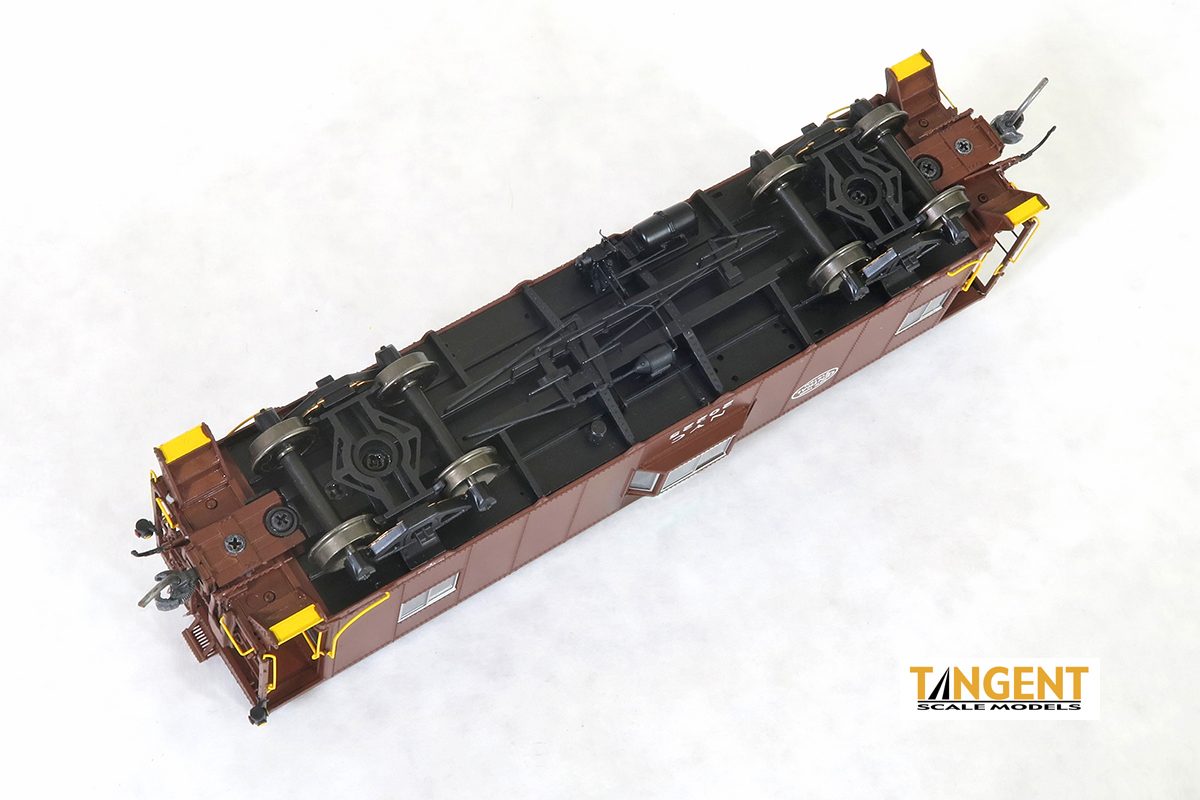

Inside the models we offer are several completely different interior designs, correct for the specific railroad and era. We have included accurately-painted interiors including the closets, sink, toilet closet, stove, bunks, desks, and chairs. Luckily these cabooses do not have any screens in the way, so you can “see” the hard work and effort applied to bring you a correct interior! Here is an example of the Illinois Terminal delivery configuration with the body shell removed; note the coal stove and signature ITC double bunks. We do not recommend removing the shell and it will void the warranty for the caboose due to the complexity of the marker lighting system.
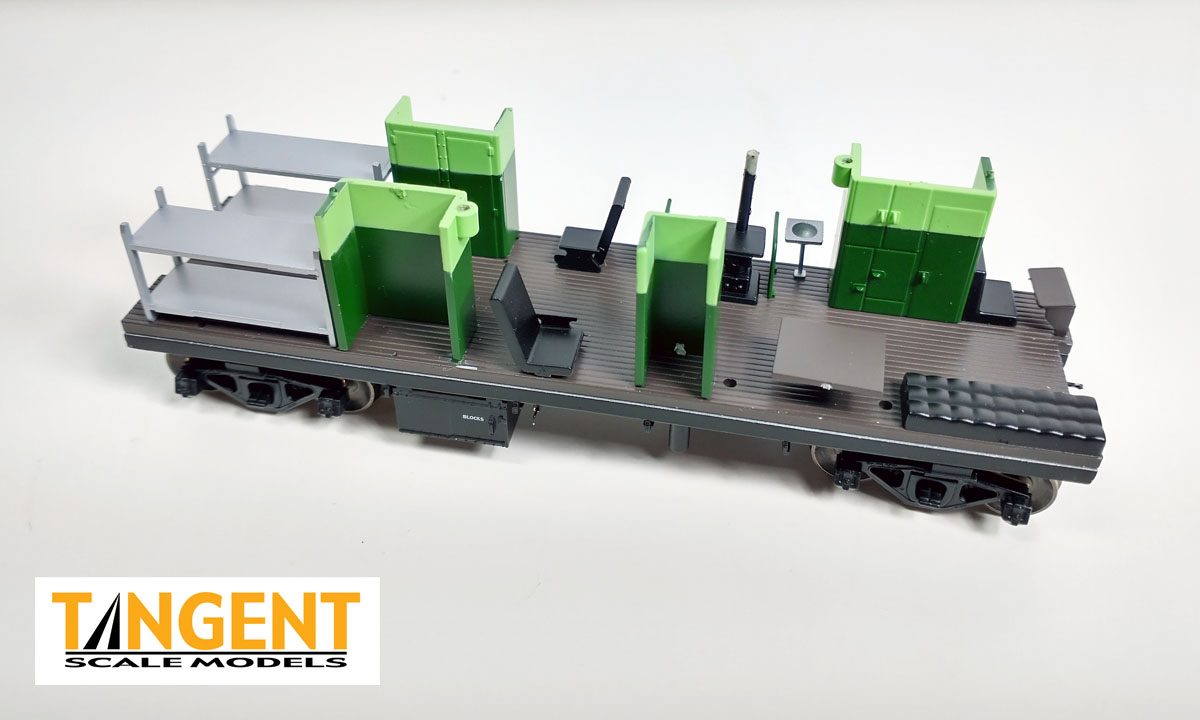
And here is a modified interior version of the NYC cabooses from the early 1960s Beech Grove refurbishment cycle. These cabooses received an oil heater but kept those stylish tufted cushions on the bunks!
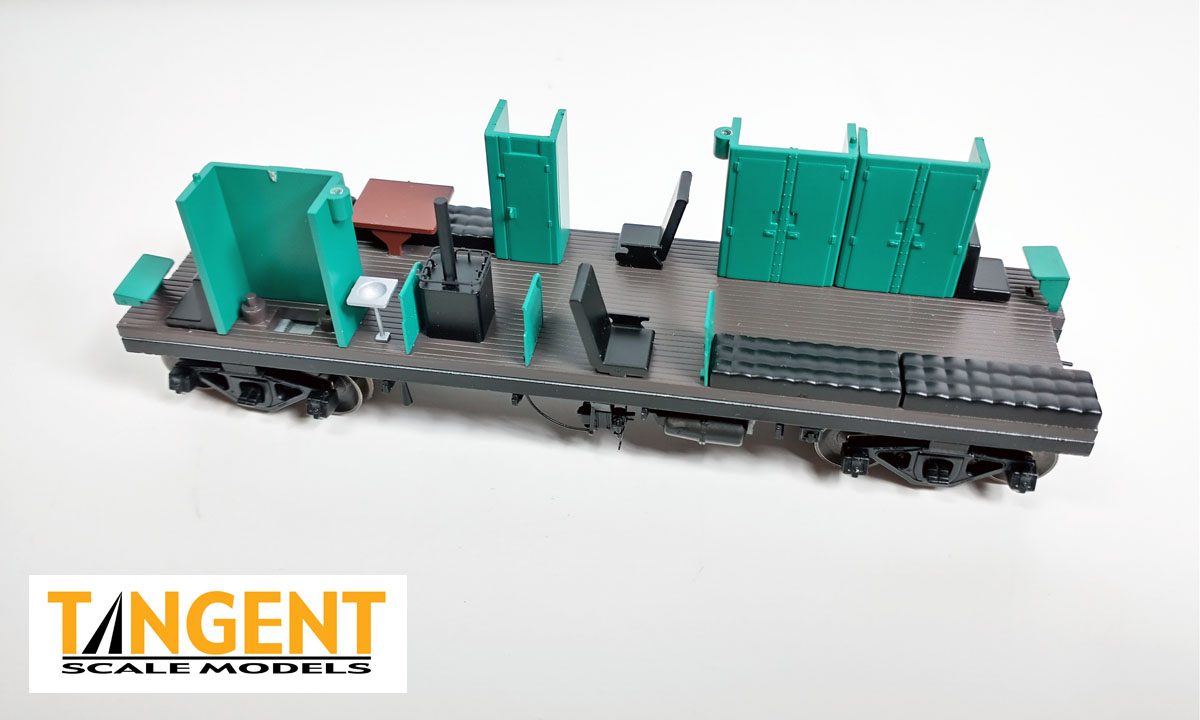
All of our cabooses include “warm” LED interior lighting. The NYC and ITC era oil lantern parts and tiny silver pyle lanterns on the corner posts (if equipped) are unlit. The red end marker lights and red (or orange) FRA flashers for the PC, CR and late ITC cabooses are lit. Instructions are included in each box that explain how to operate our lights. As an aside, Delivery brown NYC, B&A and the ITC schemes also come with a “baggy” of steel paddle “flags” for modelers to apply if desired.
Starting in the 1970s, PC began to remove the NYC-applied Pyle lanterns that were mounted on the end posts. Instead, PC applied two red marker lights in the top corners of the caboose ends. Conrail maintained this lighting configuration until approximately 1979. Here is an end view showing the PC and early Conrail version of our marker light configurations which are constantly lit red like the prototype.

In approximately 1979, Conrail began to changeover to a single flashing orange FRA light on the right side upper corner of the caboose ends. Here is a photo of that light.

In the late 1970s, Illinois Terminal added the round red FRA light (i.e. a flashing red light) that people remember fondly from what became the last gasp of the caboose era in US railroading. Here is an end view showing the Illinois Terminal mounted red FRA flasher.
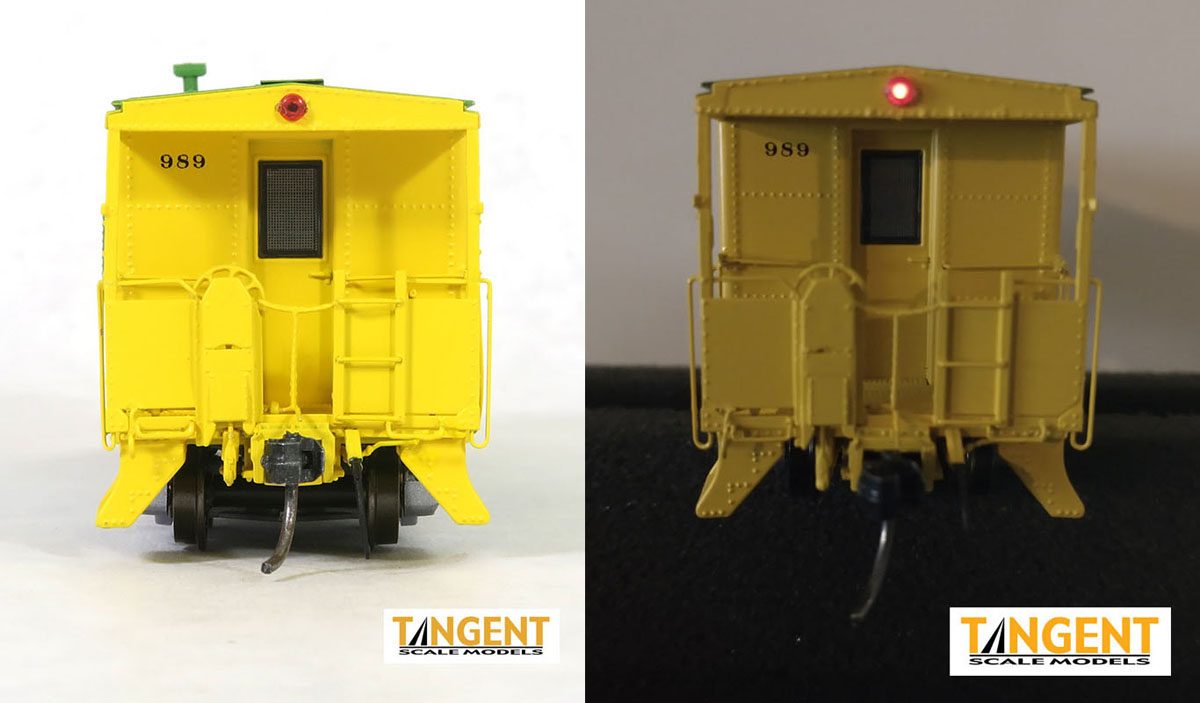
We offer “no fuss” track-powered exterior marker lights as appropriate for the prototype, and our cabooses are compatible with DC or DCC setups right out of the box (a simple wand included in the box activates the lights on each end [if equipped] – and the interior – independently). Finally, our ready-to-operate replica includes “near-scale” draft gear box including side “key” detail, coupler lift bars accompanying Kadee® scale couplers, sufficient hidden weights, and CNC-machined wheels to ensure the model operates as good as it looks.
The Tangent DSI/SLCC Steel Bay Window Cabooses are shipping today! More model photos – and prototype photos – can be found to the right in the “View and Buy” box.
Features for the Tangent DSI/SLCC Steel Bay Window Caboose replicas include:
– Dimensional accuracy – designed from actual blueprints and meticulous field dimensions using real tape measures
– Highly correct “true to life” colors
– “Hyper-Accurate” lettering including exact fonts and lettering placement
– Genuine Kadee® scale couplers
– “Near-scale” draft gear box with beautifully-rendered side “key” detail
– Multiple road numbers for each scheme, as appropriate
– Era-specific body details for each RTR scheme, including multiple body roof and end window combinations
– Wood, Apex “See through,” or no roof running boards/etch metal running board supports, as appropriate for the era
– Railroad and era-specific ladder roof hand holds: Round, square, and none
– Multiple roof equipment options including locker vents, radio antenna and toilet vent
– End steps to match the prototype: Kass, Diamond, or “See through” Apex
– Two different end walkways platforms – Diamond and Kass – based on the prototype
– Unapologetically fine etch metal end window screens, where appropriate
– Thirteen (yes, 13!) different end railing/safety appliances options, based on railroad and era
– Seven different smokejacks to cover DSI, SLCC, PC and other replacement options
– Unlit NYC/ITC oil lantern and NYC pyle light options on the corner handrail posts where appropriate
– Illuminated scale-sized PC and CR era end marker lights that can be controlled on or off – on each end – independently, where appropriate
– Illuminated scale-sized CR and ITC late-era FRA end lights with a proper slow flash/prototype “decay” that can be controlled on or off – on each end – independently, where appropriate
– Multiple side oil fill and overflow pipe options based on the prototype and era
– Two “coupler lift bar” options per prototype application and era
– Railroad specific battery/equipment box options
– 4 different toilet pipe options based on the prototype and era
– Windshield wipers applied to bay windows based on era and prototype use
– Full railroad-specific interior – chairs, bunks, desks, lockers, sink and even 2 stove options! The interior is accurately apportioned and fully-painted with railroad and era-specific detailing. From the signature ITC double bunks to the NYC fold-down table and tufted cushions.
– Full underbody details – brake system with brake rods and piping, battery box, electrical plugs and conduit, water fills, axle generator and more – all based on the prototype and era!
– Beautiful side details – wire grab irons, wire ladder rungs, wire roof hand holds, and wire coupler lift bars – no “molded in” plastic grab irons here!
– Separate air hoses with mounting bracket detail
– No complicated decoder. No complicated programming. No complicated electronics. DC/DCC compatible track-powered “no fuss” interior and marker light lighting – simple and easy to operate with included wand
– “Warm” color LED lights for that “incandescent bulb” look of the prototype
– CNC-machined standard RP25 .110” tread 33” wheels (Yes, semi-scale .088” wheels are available separately!)
– All-New precision Tangent Scale Models 70-ton Gould plain-bearing trucks with separate brake beam part, or 70-Ton Gould roller-bearing trucks with separate brake beam parts, as appropriate for each paint scheme
– Recommended age 14 years and older
Please click on the images at right for pricing, SKUs, high resolution photos, prototype photos, car number options, and/or to order!
You probably already know this, but it is worth repeating. Approaching models to the level that Tangent executes requires a significant contribution of time, effort, and money. Our field dimension work equaled three full days – to insure we got every dimension we needed to meticulously detail the real thing prior to undertaking design. Of course the field work is not even half the battle, but it may be the most fun! Here is a quick montage of our multiple days photographing and measuring caboose examples of all three builds for this project. Many thanks to the people who have helped us along the way, including the city of Franklin, IN and the caboose parked by the depot in town. We recommend eating the ice cream and seeing the railroad memorabilia in the Franklin Depot! Thanks also to the Ace Hardware store in Pocopson PA and the DSI-built car on premises there complete with Penn Central modified railings. Finally, thanks to the Illinois Railway Museum for housing one of the former Illinois Terminal cabooses!
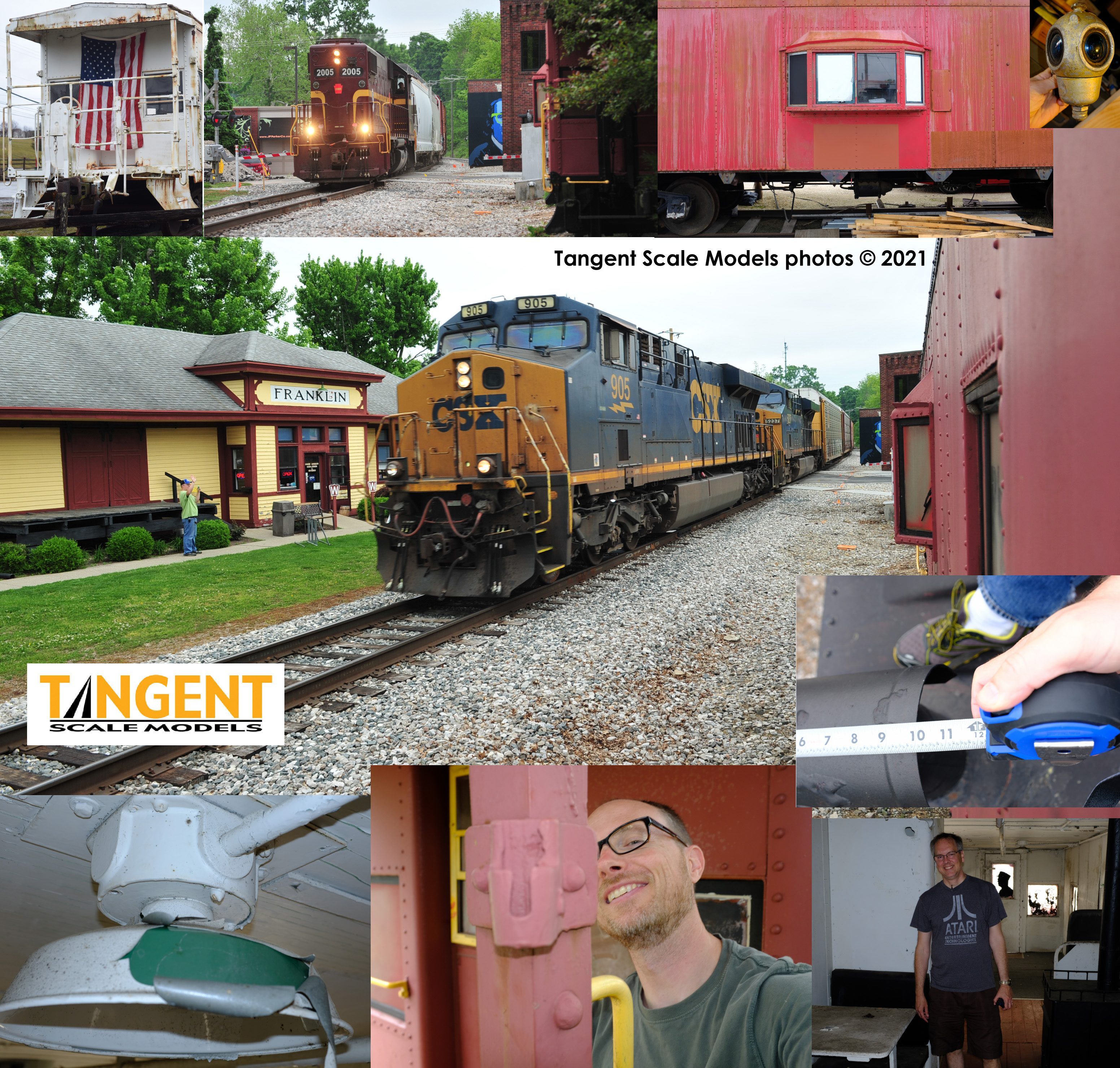
Please click on the images at right for pricing, SKUs, high resolution photos, prototype photos, car number options, and/or to order!



